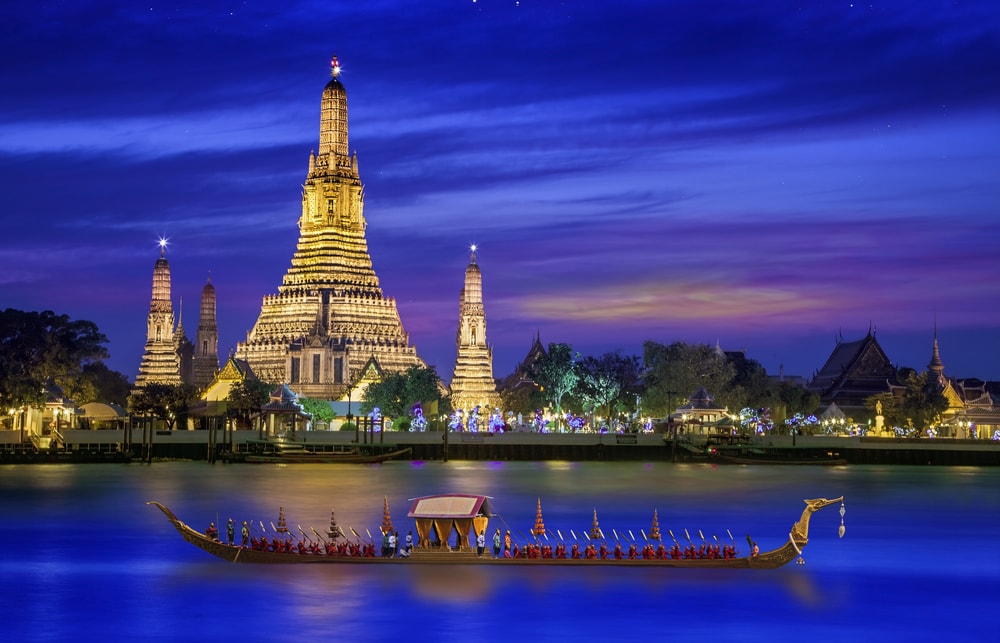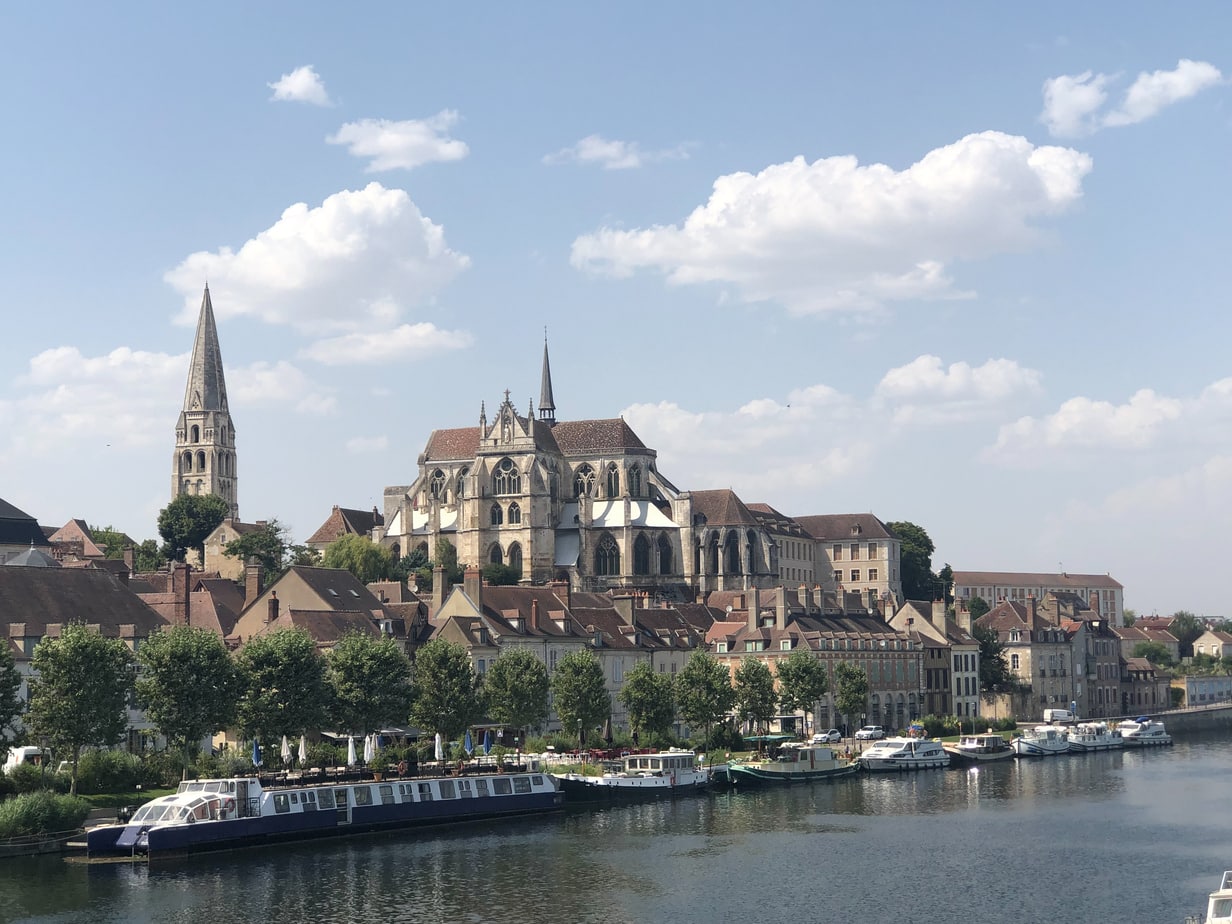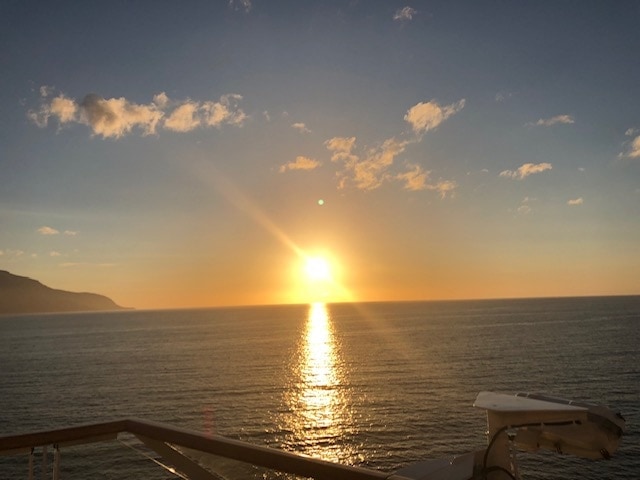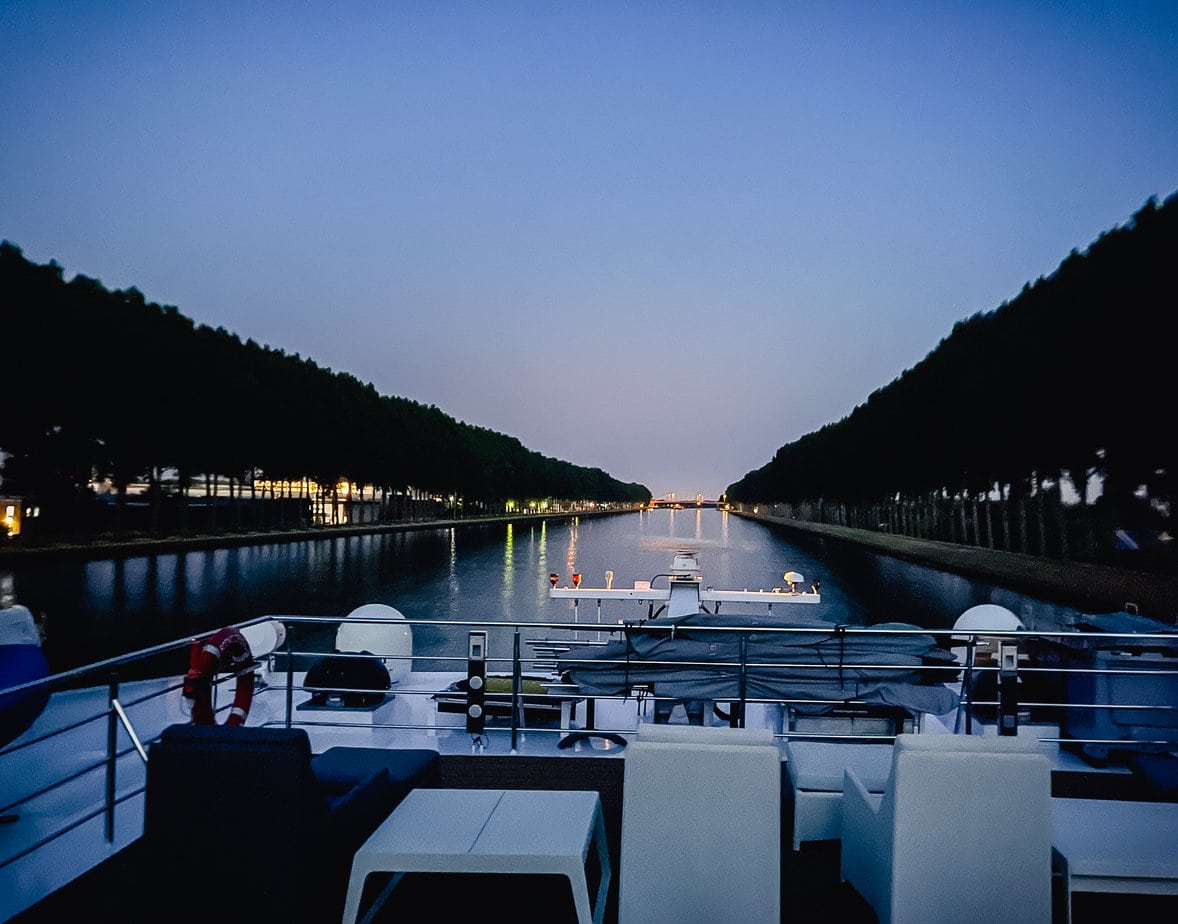The Mekong, one of Asia’s longest rivers, stretches through Cambodia, China, Laos, Myanmar, Thailand, and Vietnam. The river system supports myriad ecosystems and habitats, and is known for its scenery and diverse cultures. The Mekong Delta, located in the southern part of Vietnam, is a particular wonder. This area has become famous for its network of waterways, floating markets, and rice paddies, and is a fascinating component of any Mekong cruise.
We are unapologetically cruise lovers. Big ships, small ships, and ships in between. Oceans, rivers, canals. We enjoy them all for different reasons, different occasions, and different experiences. We believe there’s a cruise that’s right for most every kind of traveler. It’s just a matter of considering your interests and preferences and matching them up with a cruise line and cruise itinerary that meets those preferences.
Knowing where to start, and the questions to ask may seem overwhelming. That’s why we continue to write about different types of cruising, different ships, different cruise lines, and different itineraries. And we go indepth, all in one story, so you don’t have to hop around looking for everything. You’ll find what you need to know right here – cabins, food and beverage,cruise pricing (which is highly variable), itineraries, what we did, any mistakes we made, and all of our recommendations. Our goal is to help you make an informed cruise choice, and to enjoy cruising as much as we do.
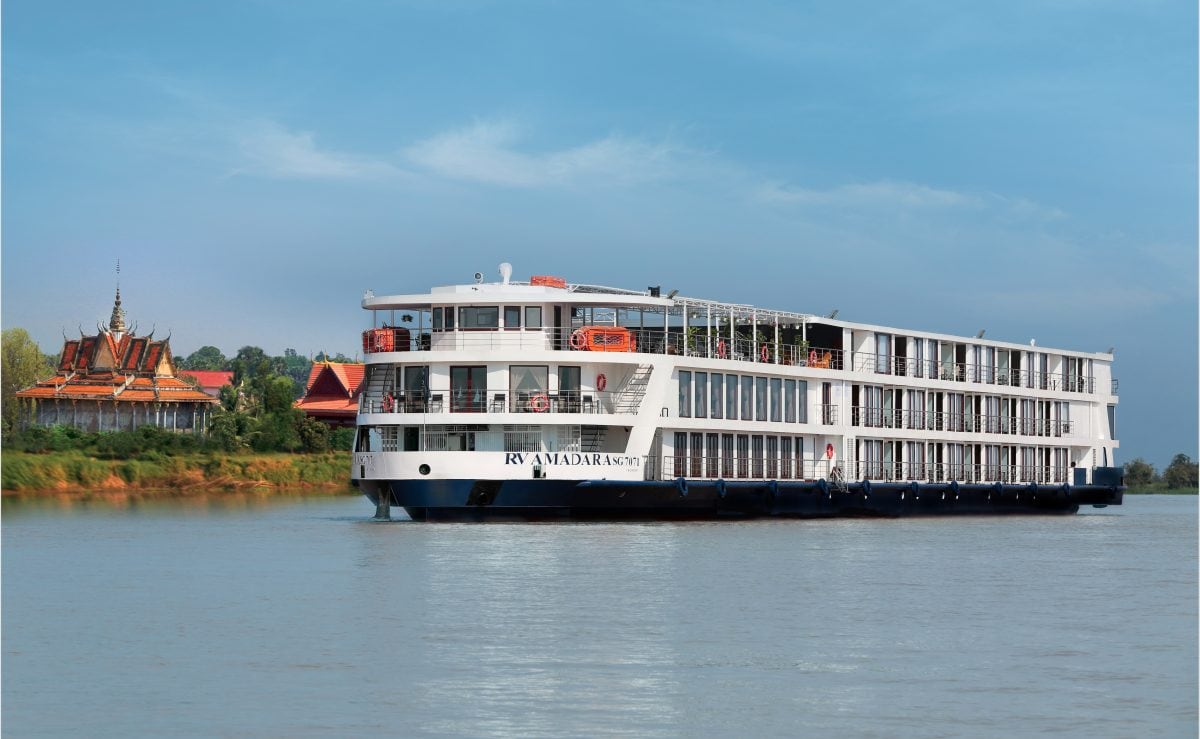
For our Mekong cruise, we boarded Ama Waterways AmaDara in Cambodia, heading to Vietnam. The historical look at countries that are so often misunderstood was a primary reason we were excited about this itinerary. We were ready to slowly move through the heart of the Southeast Asia countryside, with glimpses of daily life along the river.
Sail along with us!
NOTE: We received a complimentary sailing as media covering the ship and the itinerary.
Mekong and Mekong Delta
The Mekong River originates on the Tibetan Plateau, then flows through several Southeast Asian countries before emptying into the South China Sea. Its lower course, the Mekong Delta, is a fertile region in southern Vietnam, characterized by a network of rivers and canals. The Delta,is often referred to as the “rice bowl of Vietnam,” and for people living in the area, life moves in sync with the rhythm of the water.
History and Economic Significance
The Mekong flows through six countries and millions of people rely on it for survival. To understand the importance of the river, one must look to the past, where the river’s history goes back centuries.

At the southern end of the river, in Vietnam, is the Mekong Delta, a fertile spot thanks to the rivers and canals that run through the region. The Delta is an agricultural area that supports local livelihoods and contributes to the global food supply. It’s been a hub of civilization for centuries, including the Khmer Empire that once flourished along its banks.
However, the mighty Mekong River faces increasing pressures which pose significant challenges to its ecological balance and the livelihoods of the people who depend on it. Dam projects along the river are changing its natural flow, and climate change and pollution are putting a strain on the ecosystem. These problems aren’t just about the environment theoretically, these changes affect the people who rely on the river every day for farming, fishing, and transportation.
The Ship: AmaDara
The AmaDara was launched in 2023 and was designed explicitly for the Mekong River. It is currently the only ship that AmaWaterways operates in Asia. The spacious cabins and public space evoke an old world elegance, understated as opposed to noveau, with lots of dark wood and Asian art. While the decor may evoke the not so halcyon days of colonial rule in this part of the world, it was, nonetheless, well laid out and inviting. Guests will find it a refreshing change from European river cruise ships.l

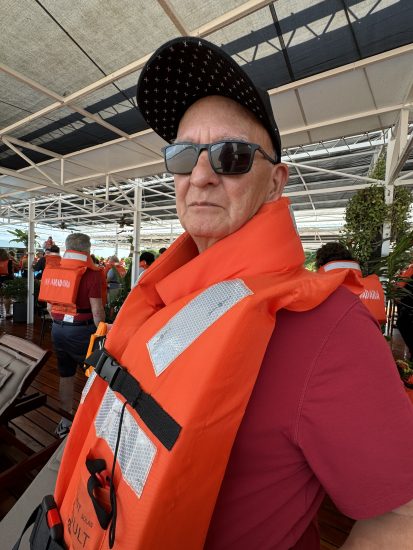
The ship has a passenger capacity of 124 passengers, with 62 staterooms, and a crew of 52. The crew is all hired from the countries served (Vietnam and Cambodia).
Let’s take a look at the ship.
- Sadec (Sun Deck) – Deck 3 features suites and staterooms, as well as the Navigation Bridge, Bar, Sun Deck, Pool, Sadec Spa, and Fitness Room.
- Saigon (Upper Deck) – Deck 2 features staterooms, and the Saigon Lounge & Bar, Reception, Public Computers, Gift Shop, Saigon Spa, and The Chef’s Table Restaurant.
- Tonle (Main Deck) – Deck 1 features staterooms and the Mekong Restaurant.
NOTE: The AmaDara is scheduled for dry dock and plans include some cosmetic refreshes on the ship. The update won’t change the overall vibe of the ship.
Restaurants and Dining
There are a few options for enjoying the food and beverage experience on the AmaDara. While menus include traditional Western fare (burgers, steaks, chicken), there is an emphasis on local dishes, spices, and flavors. You’ll soon discover that these local dishes are much different than the Western versions you may have tried at home.

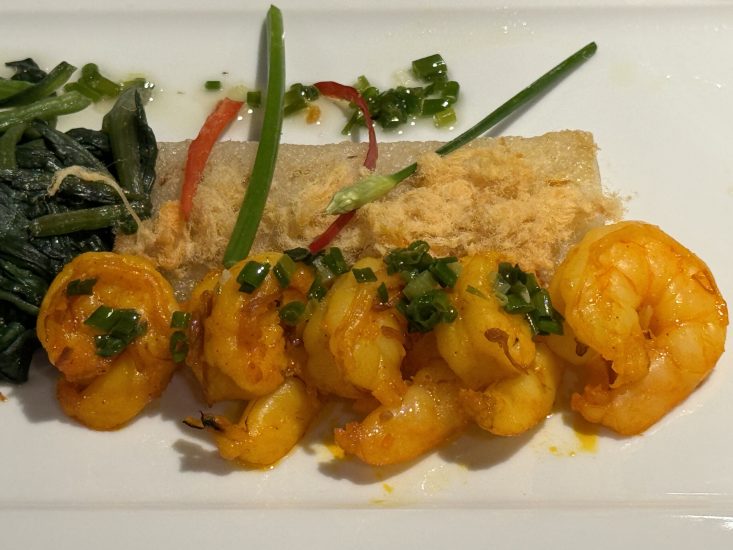
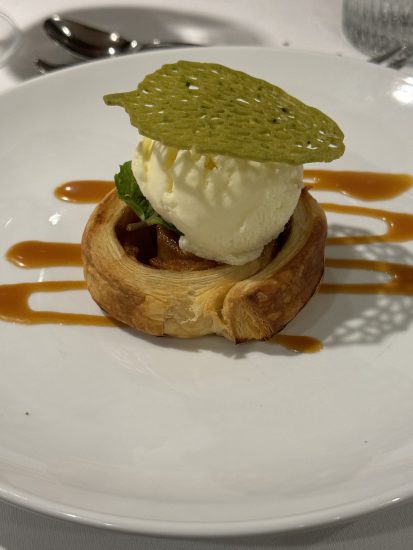

Beer and wine are complimentary at lunch and dinner. House brand spirits, local beer, and soft drinks are complimentary throughout the cruise.
The Mekong Restaurant
The Mekong Restaurant, located forward on the Tonle Deck (deck 1) of the AmaDara, is the main dining room, and is where you’ll enjoy most of your meals – breakfast, lunch and dinner. The menu has both local and traditional American cuisine, so you’re sure to find dishes to suit your palate and mood. The setting is relaxed, with just a touch of an upgrade at dinner time.

Breakfast and lunch were served buffet-style, accompanied by a short list of menu items. Dinner was offered from a multi-course menu that included both local Asian dishes and traditional American fare. While not Michelin-star dining, we found the cuisine tasty, graciously served, and with sufficient variety to suit both of our preferences. With local dishes served at breakfast, lunch, and dinner, it’s a great time to explore some new menu choices.
TIP: The burger at lunch was outstanding. It is a bit of an unexpected choice, especially on an itinerary in Asia, but don’t leave the ship without trying it at least once. Probably the best bun I’ve ever had.
The Chef’s Table
The Chef’s Table Restaurant, located aft on the Saigon Deck (deck 2) of the AmaDara. It’s a fine dining experience that showcases the culinary talents of the ship’s chefs. Guests can savor gourmet dishes from a specially prepared menu in an intimate setting. Reservations recommended.
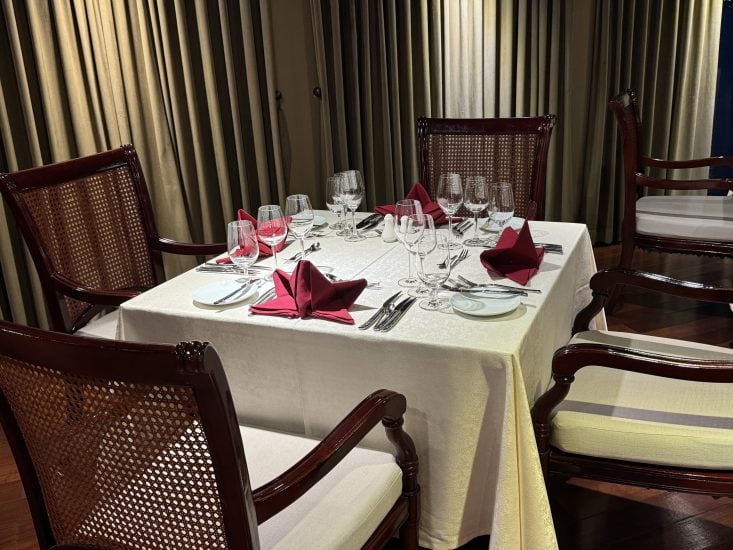

TIP: Schedule this for at least one time on your cruise.
The Saigon Lounge & Bar
The Saigon Lounge & Bar, located forward on the Saigon Deck (deck 2) of Amadara, is a relaxed and convivial place to enjoy a wide selection of drinks. Snacks are available.

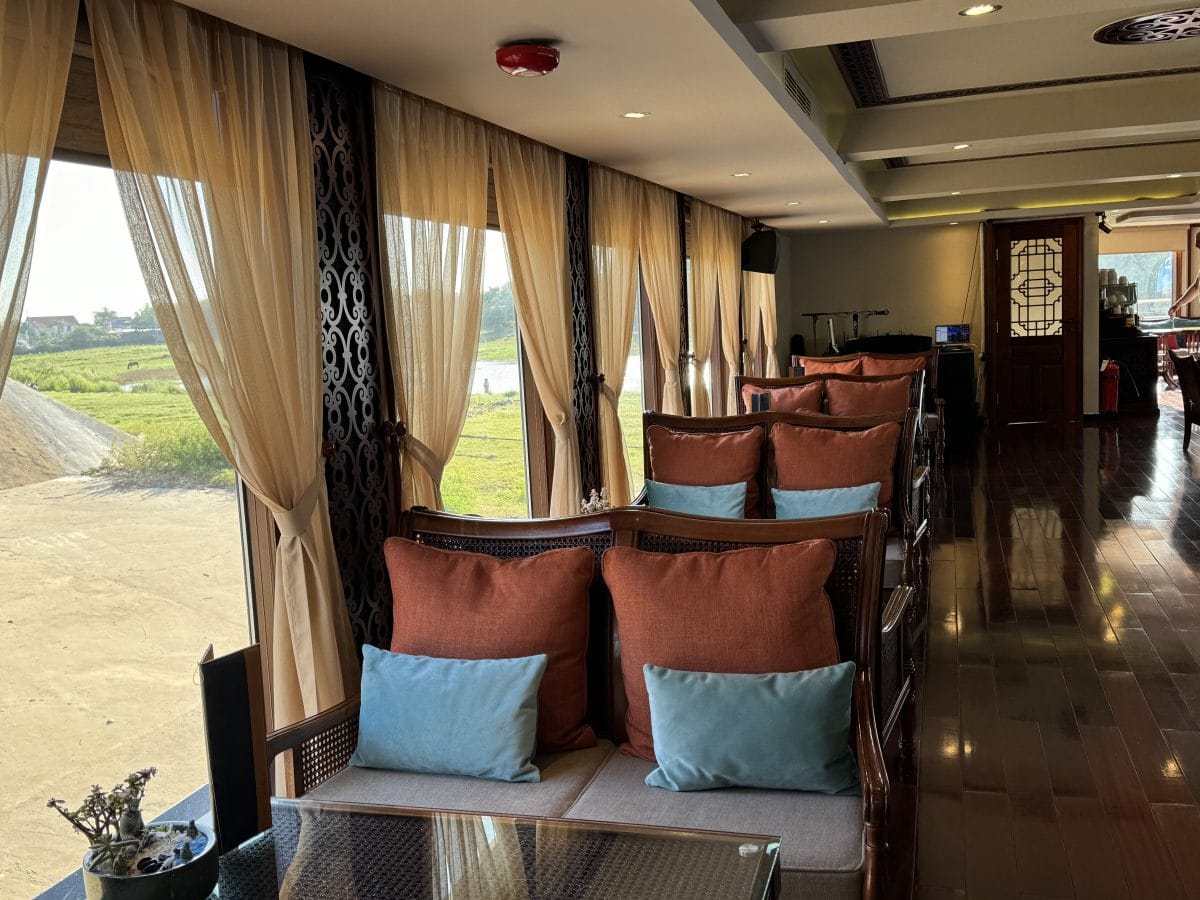
This is the ship’s main gathering area. It’s the meeting place for entertainment, port talks, demonstrations and other enrichment programming, meeting friends, and shore excursions. Wifi is strong enough to work from the road (or water, more accurately), there are couches for reading and a cup of tea, and you’ll soon find it the hub of activities onboard the ship.
Sadec Pool Bar
Located forward on Sadec (top deck), the pool and lounge area is full of verdant plants, comfortable seating, and a bar. While the pool area is not covered, the lounge area is. You’ll appeciate that cover when the sun brutally beats down. When sailing, there is a nice breeze sweeping across the deck, and at less breezy times, ceiling fans are in use. In the tropical climate of Vietnam and Cambodia, you grow to appreciate these breezes.

This was a favorite spot for us to meet up with friends to recap our day accompanied by a refreshing beverage.
AmaDara Cabins
Cabins span five categories of accommodation: from luxury suites, suites, and three categories of staterooms.
Cabin selection is a very personal thing. Everyone has different priorities and preferences. My recommendation for cabin selection is to select the best that your budget allows. The entry-level cabins are smaller than the suites, of course, but don’t let that get in the way of deciding whether or not to book. Look for special pricing, take a close look at the amenities offered in each stateroom category, and do the math to determine the value of what’s included and where you get the most value. It’s about what right for you.




We were in cabin 313. This mid-ship suite was on the starboard side on Sadec. We had a queen-sized bed, sitting area with table, and desk/work space, and still had plenty of room to store our clothing and move around. The cabin had both a private balcony with seating and a French balcony. The floor-to-ceiling windows provide substantial light in the cabin, along with great views of local life along the Mekong. The bathroom was spacious and had a shower and bathtub.
Riches of the Mekong Cruise Itinerary
The Riches of the Mekong itinerary is a simple way to connect to a complex area of the world. We visited peaceful temples surrounded by lush greenery, walked through palace grounds, saw intricate architecture, and met locals. We felt history just as much as we saw history. If ever the “it’s the journey, not the destination” applied, it was to this itinerary.
I always recommend arriving at least one day early for a cruise. Delays happen, and that can mean cancelled flights, late arrivals, missed connections, and jetlag. The time and expense of getting to Siem Reap, our starting point, is substantial. There was no way we were risking any problems.
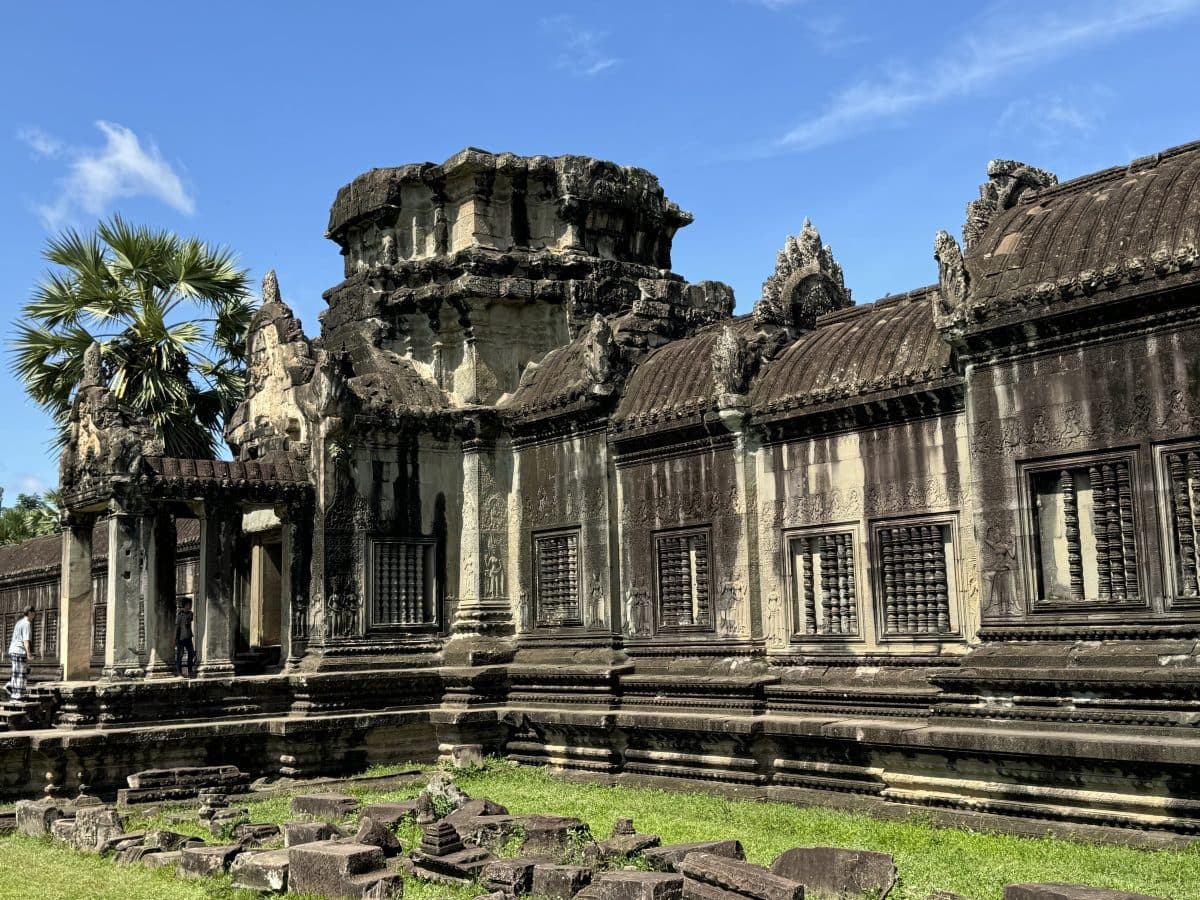
We arrived one day before our scheduled departure and stayed at the Sofitel Angkor Phokeethra Golf & Spa Resort. Located near the ancient temples of Angkor Wat, the resort is the one booked by Ama for passengers on pre-tours. We spent a day exploring Angkor Wat, and then shook off remaining jetlag in the swimming pool with swim-up bar. Delightful luxury, and we both wished we come in another day – or two – earlier for further Siem Reap exploration.
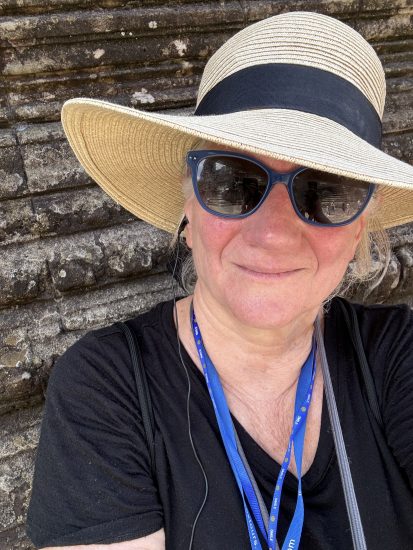

Our recommendation: Come in more than one day early. There’s much to see and do in Siem Reap, whether you opt for a structured tour (we recommend that to get the most out of Angkor Wat) or explored the city independently (which we didn’t have time for).
Here’s a breakdown of what each day looked like, what we did, what we’d do differently, and some of our recommendations.
DAY 1: Embarkation in Kampong Cham
The journey began with a scenic motorcoach transfer from Siem Reap to Kampong Cham, to board AmaDara. It’s a long drive from inland Siem Reap to the river, about four and a half hours, but it’s broken up with a stop for lunch. Although I occasionally have issues with motion sickness on road trips, I had no issues. Between the sights out the window, listening to an audio book (see details on books about Cambodia and Vietnam below), and a few minutes of napping, the time passed easily.
Every time I board a ship, big or small, familiar or new, and regardless of the setting, I’m always excited about what’s in store. A little shiver of excitement ran up my arms as we were warmly greeted, shown to our stateroom, unpacked, and got ready to begin our week on the Mekong.
And. . . we’re sailing.
DAY 2: Angkor Ban & Oknhatey Village
Angkor Ban is a commune in the Battambang Province of northwestern Cambodia, and Oknhatery, often called Silk Island, is a small island on the Mekong.
We went on a morning walking tour in Angkor Ban. The village was fortunate to avoid destruction during the brutal Khmer Rouge regime of the 1970s, and villagers continue daily life in traditional wooden stilt houses, with banana trees providing shelter and shade. The village was likely spared ruin because the buildings in the village were used by the Khmer to house men and supplies.
We met local families who graciously and proudly talked about life in their village, and showed us around their multi-room homes and their village. There are no highways or upscale shops here, just rural life centered around agriculture, livestock, and the temple.
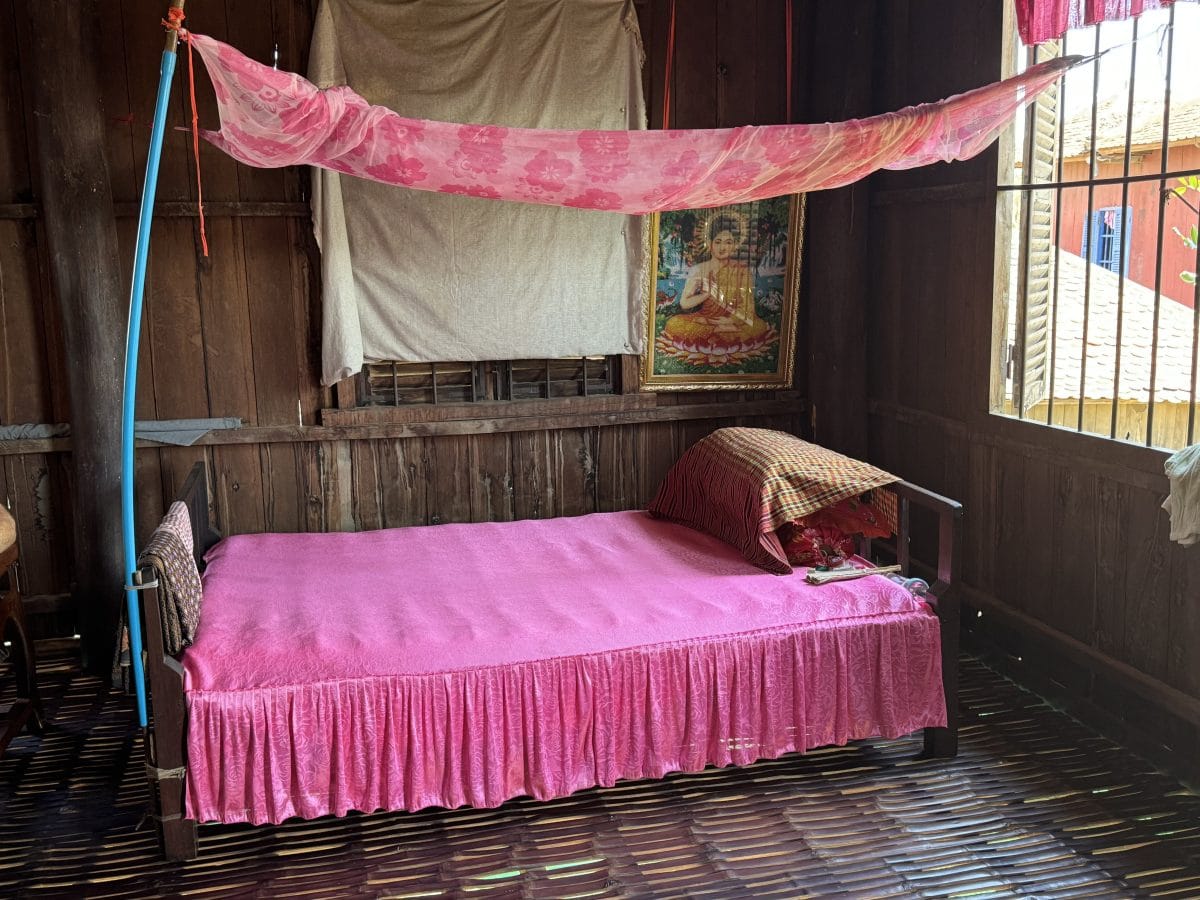

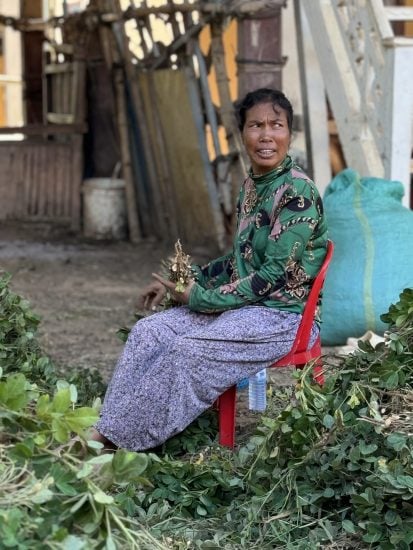

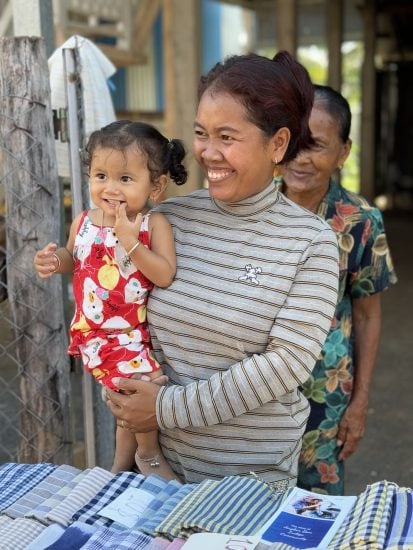
TIP: Keep an eye out for blue houses, doors, shutters, and designs. Blue is believed to be a lucky color that invites happiness to life, and most homes incorporate the color in some way.
After sailing to Oknhatey Village (you may also see it written as Koh Oknaha Tey), we climbed into tuk-tuks to visit a local elementary school. An alternative option, which Tony took, was to walk instead of using tuk-tuks.
We both spent time in the classroom with elementary aged kids, breaking into small groups to talk with the kids and help them practice their English. At first it felt awkward; then the questions were flying. They were hungry for additional information about who we are, why we came to Cambodia, and what words meant. When asked what they wanted to be when they grew up, the kids had a few common goals – becoming a doctor, a teacher, or working in tourism – the latter perhaps as result of travel inspiration from village visitors.
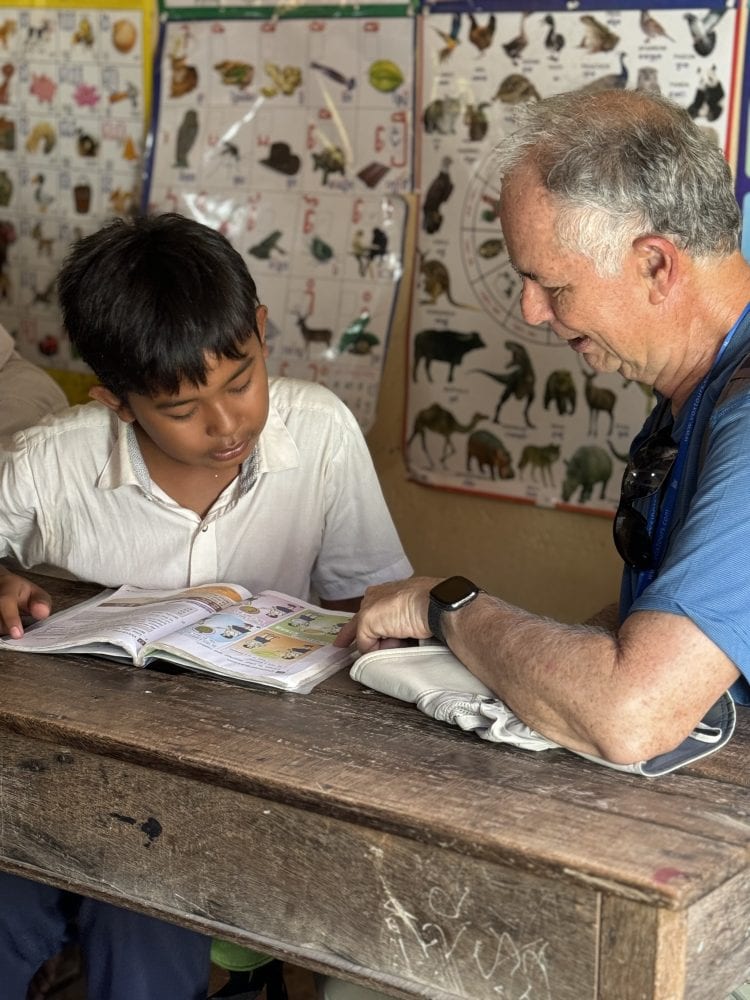
TIP: Gifts to students are prohibited, however Ama Waterways partners with generous donors to provide supplies and technology to the school. Check with them for opportunities on how you can help.
We then saw silk weavers in action, crafting intricate designs on massive looms. All done by hand, as it has been for generations. We learned about the entire process of silk weaving, from inception with silk worm breeeding, to the beautiful end products.
DAY 3: Oudong & Phnom Penh
Outdong lies at the base of Phnom Udong Mountain, and was a former royal capital in the 17th-19th centuries. It is on the UNESCO tentative list, recognized for its “historical background as an ancient city of the post-Angkorian period, and persistent religious and cult beliefs maintain the mystical sacred aspect of the site.”
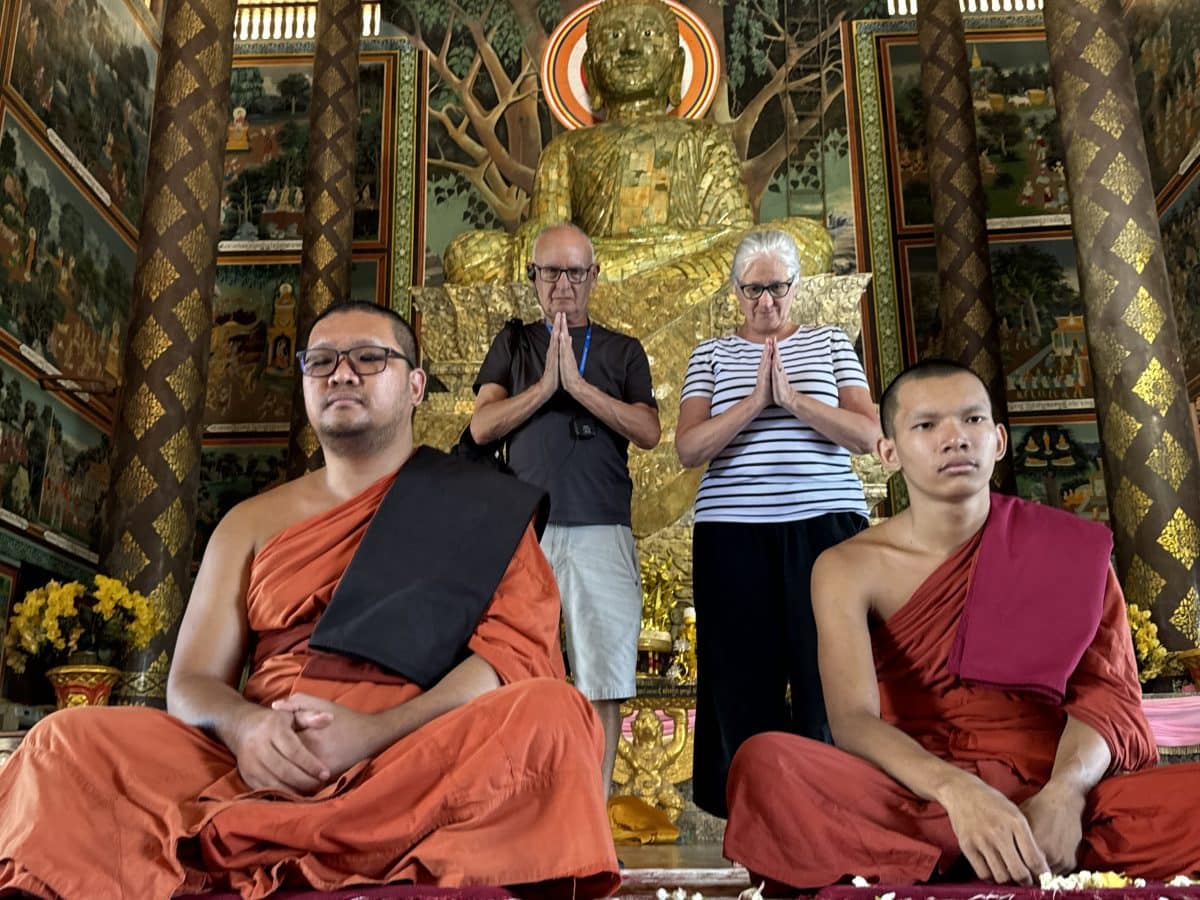
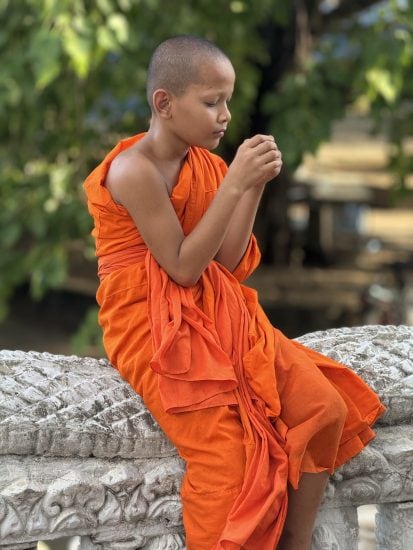

Although Tony and I decide to take different tours, we both started the day with a visit to the Oudong Buddhist Monastery where we received a blessing as part of a traditional ceremony. Following the blessing, Tony headed off for a hike up the Hill Top for a view of Ougong and an ox cart ride, while I directly headed off for that ox cart ride. The two excursions met up later.
The hike was billed as 409 stairs to the top of hill for panoramic views. Tony agreed that it was 409 steps, but the description failed to mention the hike up a steep grade to get to those steps. He says the views are stunning, but know there’s a hike and stairs to get to it. Not a problem for the physically fit, but I’m glad I skipped it, especially given the humidity.
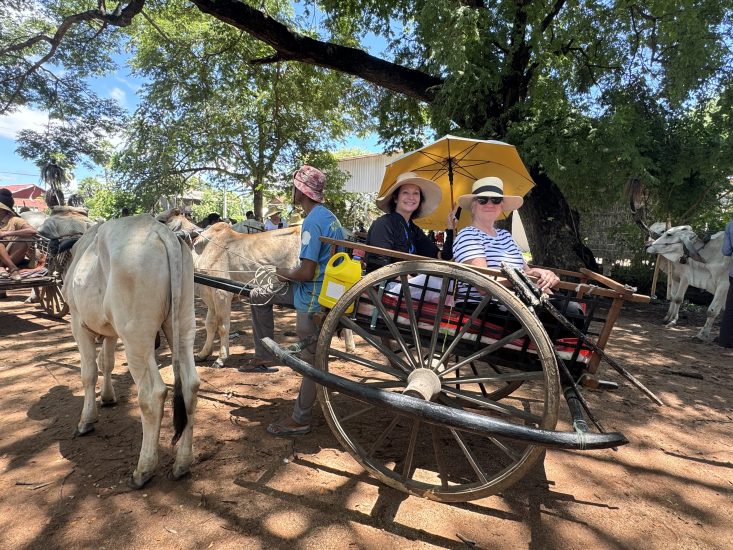

I opted for the less strenuous excursion, and headed directly to a local village for an ox cart ride. It may sound uncultured and lacking in refinement, but the ox cart ride was one of my highlights of the trip. It was such a simple thing for us, but represented daily life for people. Loading up the ox cart was a way of transporting goods as well as people, often over bumpy, well trod paths. I laughed, I had fun, and I reflected, all good things when I’m visiting somewhere new.
The ox cart ended at a craft center that had beautiful woven silk items. One of my souvenir collectibles are pillow covers, and I purchased a blue a white one. It’s now stuffed and resting on the couch in my office, evoking fond memories whenever I look at it.
TIP: U.S. currency is widely accepted in Cambodia for most transactions, so need to exchange money into Cambodian riel. Credit cards and other contactless payment were also widely accepted.
After lunch, we did a city tour of Phnom Penh via tuk tuk. Phnom Penh is the capital of Cambodia, with a population of more than two million people. Nicknamed the Pearl of Asia, it’s known for 20th century colonial French architecture and art deco. The traffic and frenetic energy of the city were a stark contrast to the morning activities.
The city tour showed us just a few highlights and took us on a crazy ride through city. It’s a city worth coming back to.
Since the ship was overnighting here, we gathered together with friends for dinner at a restaurant in the city. If you’re looking to find restaurant recommendations, check with the Ama staff onboard for some of their favorites. Remember, they’re locals.
DAY 4: Phnom Penh
Phnom Penh still bears scars from the Khmer Rouge regime and the era of genocide. It probably always will. The carnage of the Killing Fields, where more than 1.3 million people were killed and buried, cannot be forgotten. It’s an important part of Cambodia’s history, going far beyond cultural immersion. It’s also a heavy burden to visit and carry around while on vacation.
Our time in Phnom Penh created a quandary about what to do. We didn’t want to ignore history, but we knew we’d need a balance of experiences while exploring this rich culture.
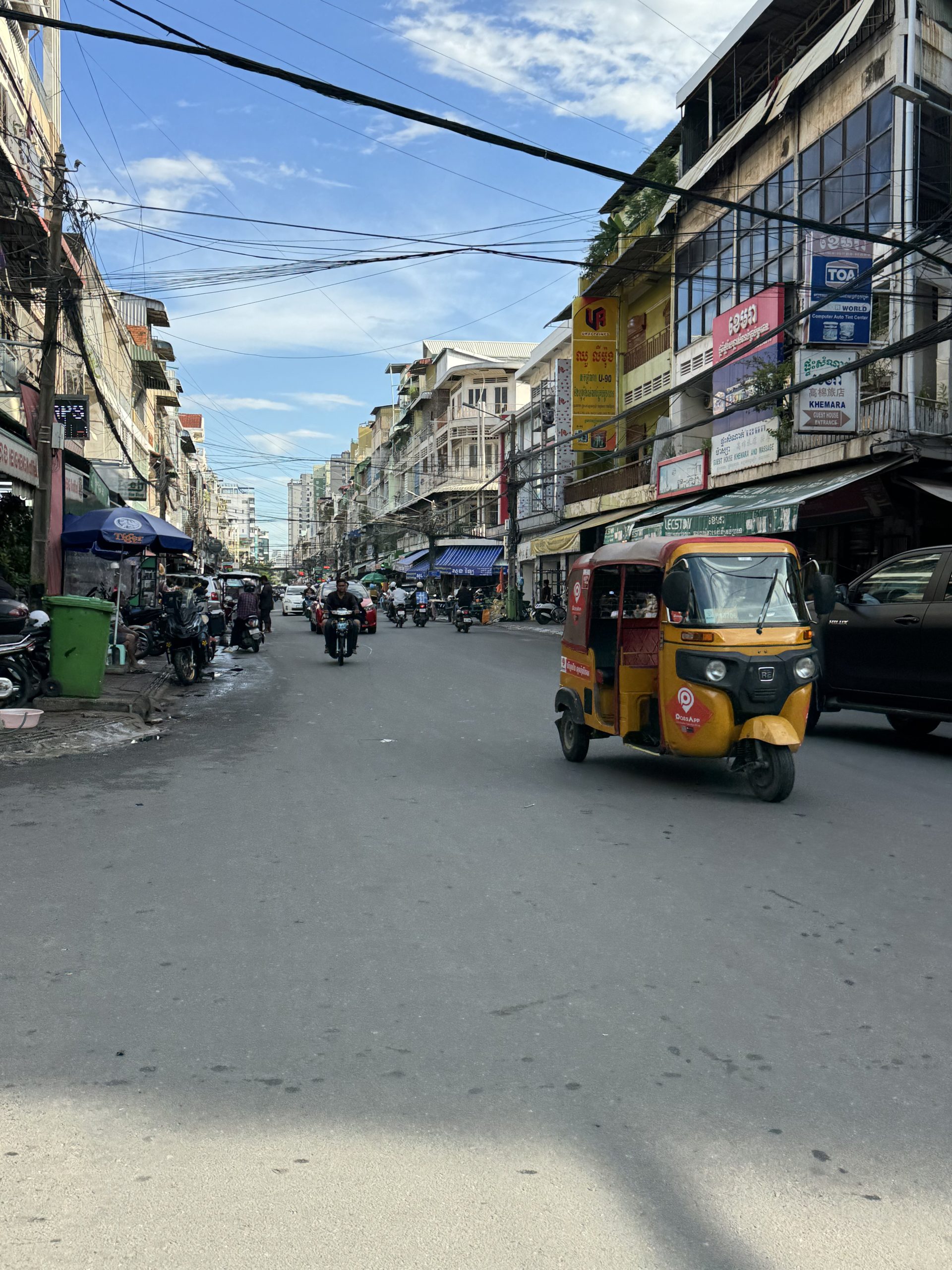
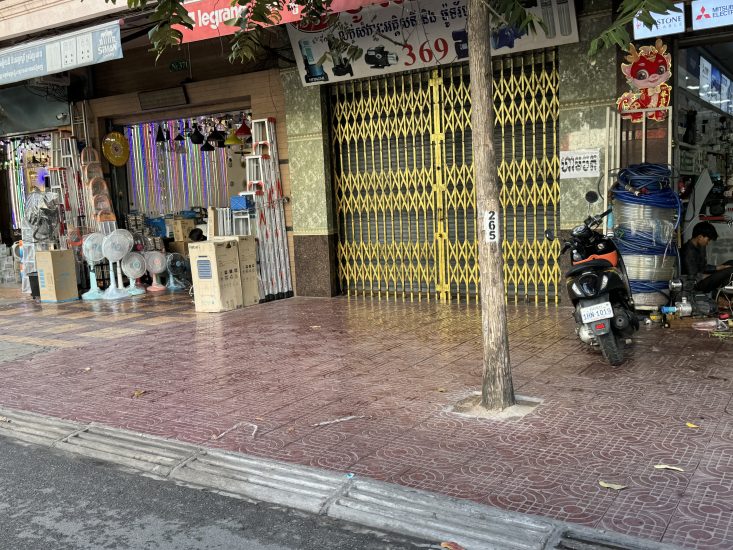
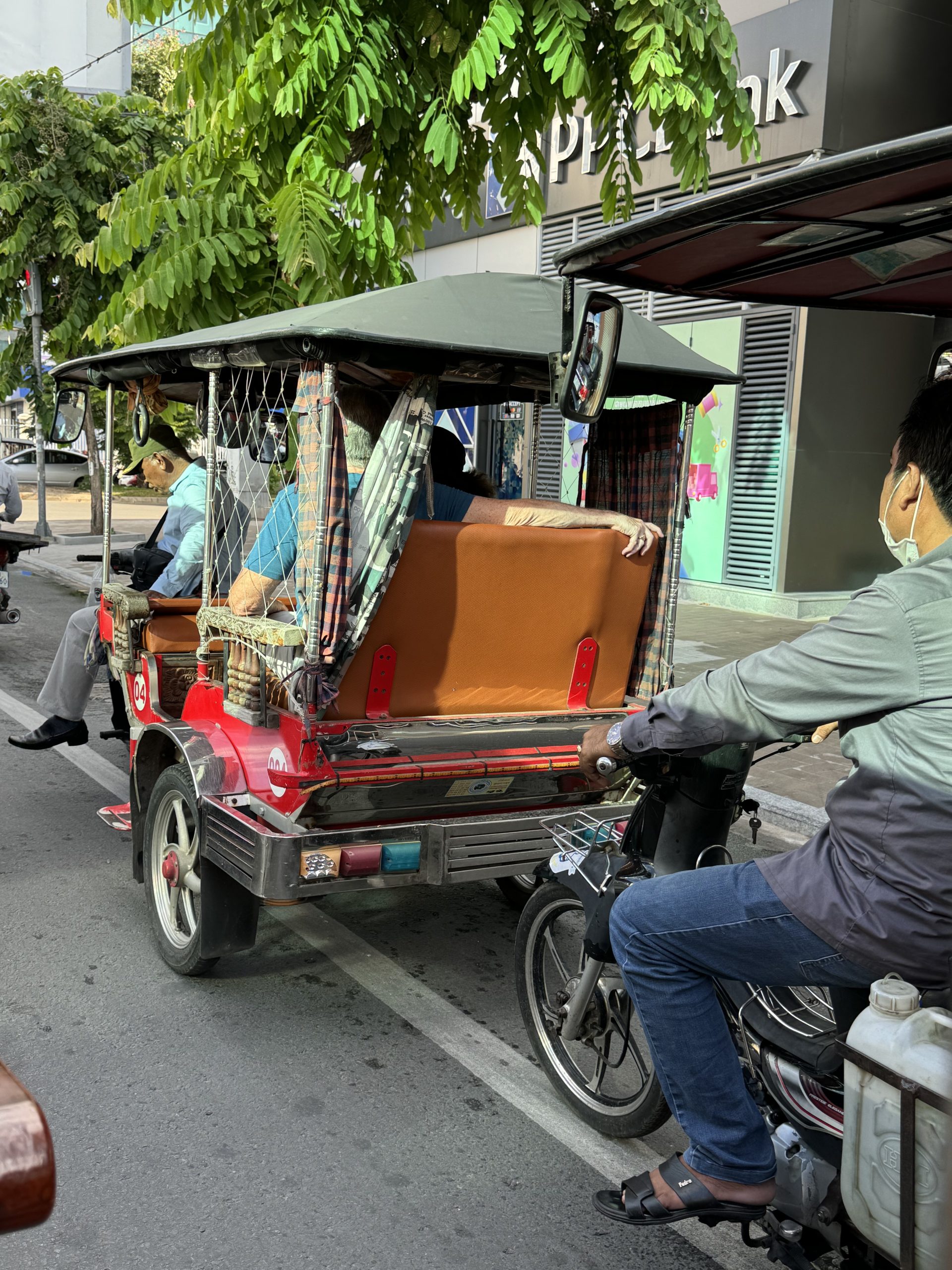
We opted for the Royal Palace and Central Market excursion. The excusion took us to see the highlights of the city, including a brief visit to a part of the Killing Fields, a visit to the Royal Palace, Throne Hall, and Silver Pagoda.
After this immersion into history and culture, we headed to the Central Market, with its art deco style and four wings radiating from the central dome. It was jam-packed with stalls selling food, clothes, souvenirs, gifts, and items needed in daily life. We wanted to do a little shopping as we had not yet had much of a chance to.
This tour provided the balance of activities we wanted, and was the right choice for us.
TIP: It’s easy to get lost in the market, so pick a couple of landmarks to orient yourself. You’ll see lots of brand names here, as many well-known U.S. companies manufacture here. Prices are reasonable, although there is still room for a little bargaining.
Other tour options substituted a visit to the National Museum for the market, and another focused on the Killing Fields (detention center and genocide museum).
DAY 5: Crossing into Vietnam
It’s a sea day! Or, more correctly, a river day. This was a treat as most river itineraries do not have a river day.
We crossed from Cambodia into Vietnam, which also involved official paperwork (handled onboard the ship). Tourist visas are required for entry into Vietnam. Ama provides up to date information abourt visa requirements and processing which need to be done before sailing. Staff also handles everything involved with Vietnam officials during the crossing onboard. We got to relax with a book and beverage, enjoying great views along the river. It’s also a great time for a spa treatment.
TIP: Make spa appointments in advance. The prices are less that what I pay at home, and a fraction of prices on most other cruises.

DAY 6: Tan Chau
Tan Chau is just over the border after crossing into Vietnam,. The population hovers around 150,000, and the area is known for its traditional silk factories, agriculture (rice, fruit, vegetables), markets, and fishing.

We chose an excursion to the Tra Su Forest and Sanctuary, a 2,100-acre sanctuary with a system of waterways that allow visitors a close up look and the flora and fauna that call it home. The sanctuary is about a two hour bus ride away from where the ship docks, so be prepared for a journey to get there. It was worth it.
The sanctuary is located on land that was ravaged during the Vietnam war (in Vietnam referred to as the American War). Post-war, provincial authorities invested in reforesting the area with cajuput trees, known to thrive in wetlands. A dike system was also installed, with anti-flood measures providing stability to the ecosystem. The work was successful, and Tra Su has been designated as a special restoration zone, and is a recognized scientific forest and nature reserve.
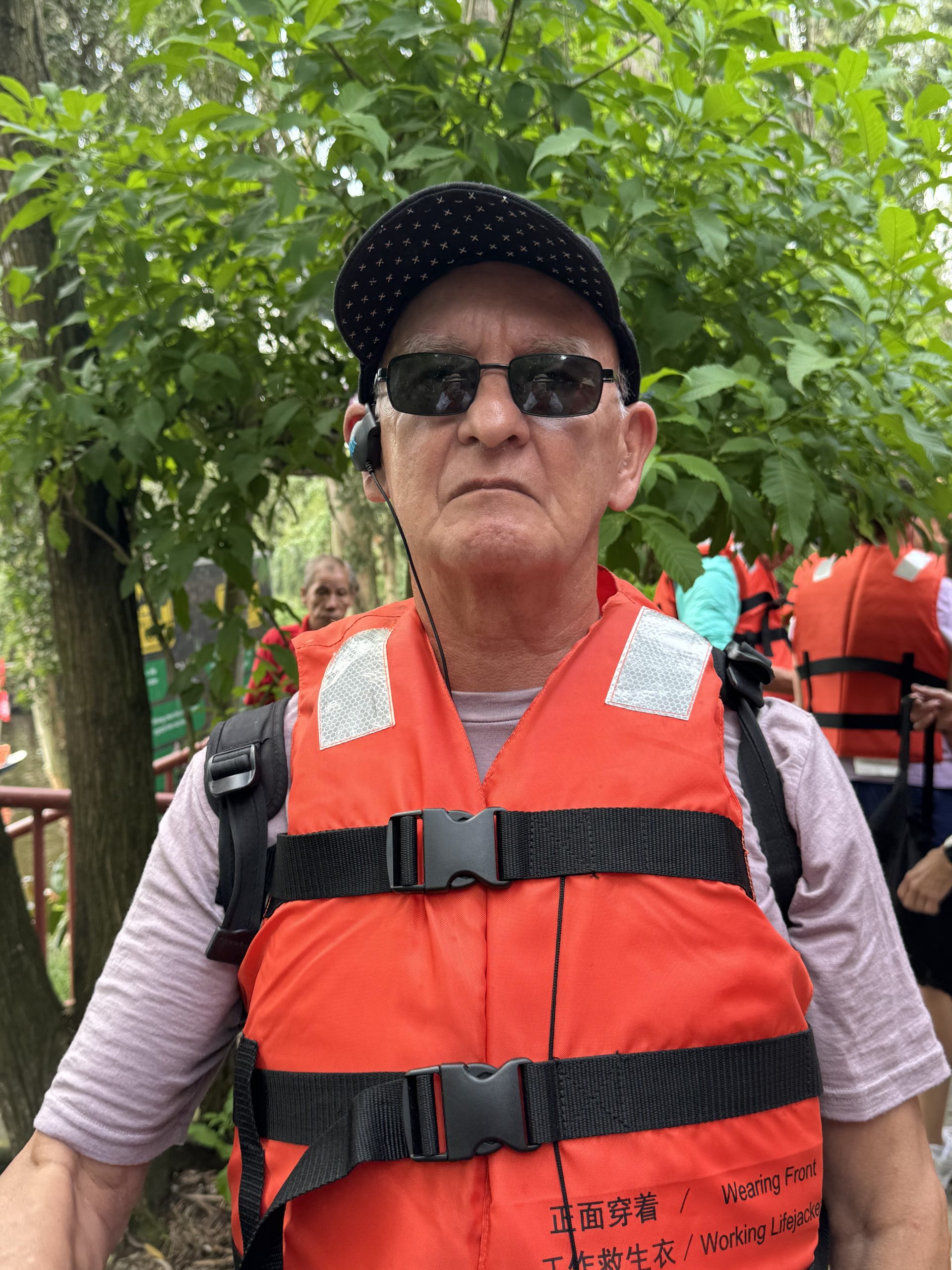
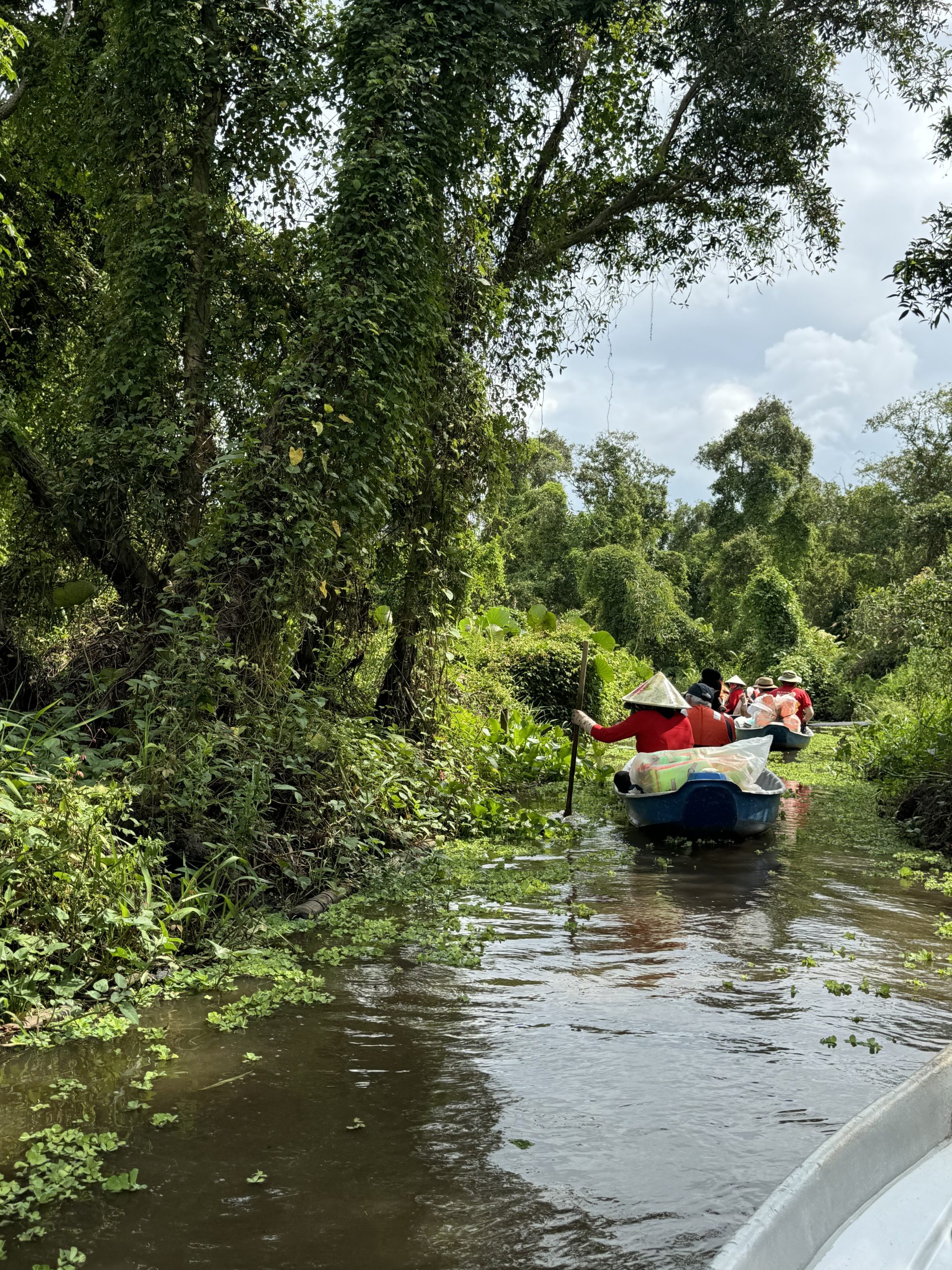

Upon arrival, we did a short orientation tour, then climbed into sampans, classic flat-bottomed wooden boats propelled by oars, to glide through the lush mangrove ecosystem. The forest was teeming with life – birds, storks, turtles, and probably snakes – every which way you turned your head. I hate snakes, so they weren’t on my list to spot. Most bird species were easily spotted, sitting in trees, on stumps, or inflight. Binoculars can be helpful. The grand dame of the forest is the cajuput trees, with a white spongy bark that seems to peel off. Oil made from the cajuput is said to have healing properties and is used much like tea tree oil.
Our time at Tra Su allowed a little bit of walking time, but on a longer there would be much more to see, including the Bamboo Bridge of Ten Thousand Steps, a 10-kilometer bamboo bridgethat’s a popular walking path.
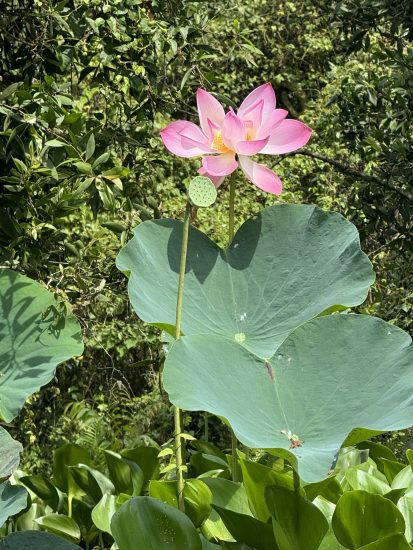
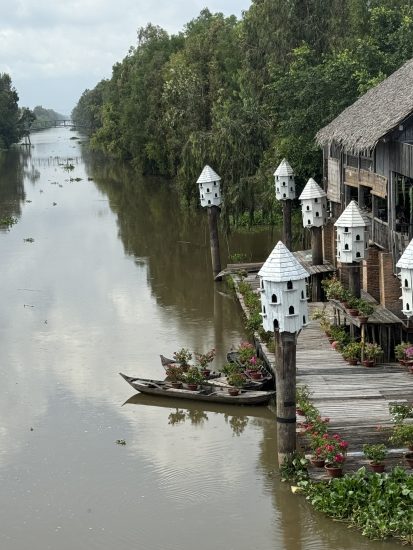

This was a great choice for us, and was just the nature fix we’d been jonesing for. Other excursions in Tan Chau included a trishaw tour of Tan Chau, with stops at a silk-making workshop, and a tour of the city with a walking tour on Evergreen Island. Other friends on the ship took the city tour and were happy with their choice as well.
DAY 7: Sa Dec & Cai Be
Sa Dec is a provincial city in southern Vietnam, and is known as an agricultural and industrial trading center. With a population of a little more than 200,000 today, it was formerly the site of a US support base during the Vietnam War.



Our morning excursion in Sa Dec included a walking tour of the local wet market. Everything you could possibly want for dinner, and more than a few things I’d pass on, could be found here.
Part of the market served wholesale clients looking for huge bags of rice and volume purchases of fish and vegetables. But there were lots of smaller vendors, though, selling to a typical shopper looking for items for dinner that night. The main part of the market seemed to be an organized chaos of regular vendors, while the side alleyways seemed to have sellers bringing goods from their backyard vegetable gardens to market.
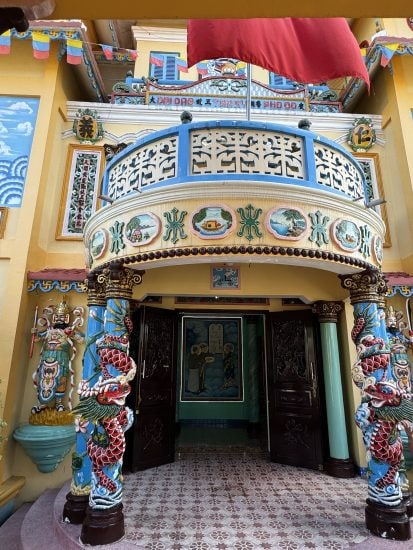
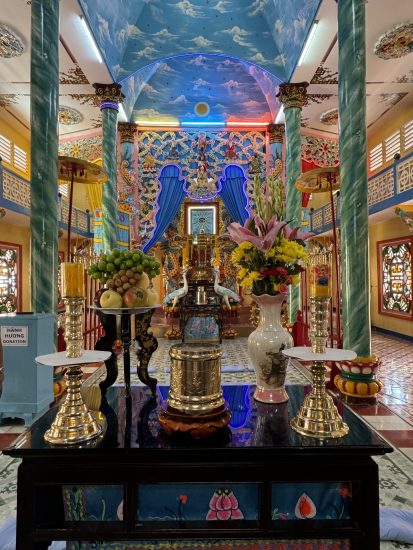
Another stop on our excursion was the Cao Dai Temple, a religious conglomerate of sorts that includes element of Vietnamese folk religions as well as practices and precepts from Confucianism, Taoism, Buddhism, and Roman Catholicism. It sounded to me like a religion that offers something for everyone, and the temple reflects that inclusiveness.
Cai Be is home to mostly farmers and fishermen, and its busiest time is in the mornings dedicated to commerce. Life plays out on the water, whether its the floating markets, boating in the canals, or relaxing in the homes built along or over the water.
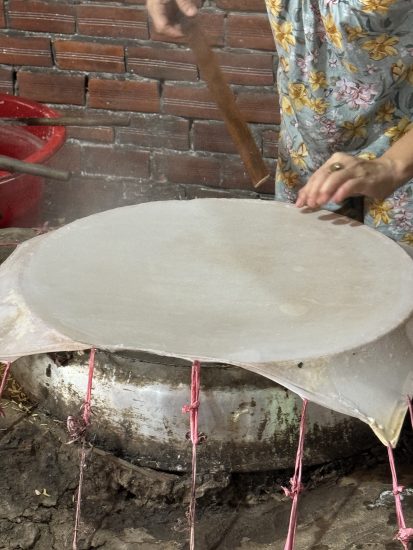
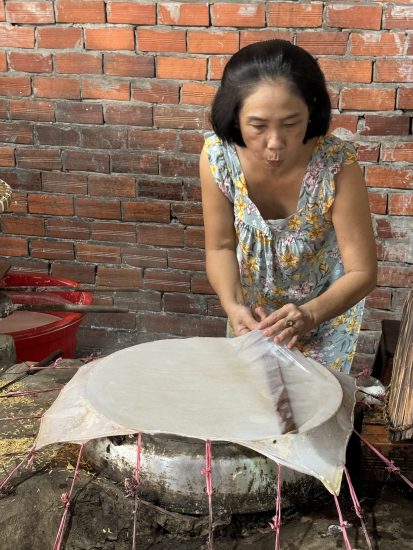
The afternoon excursion was a visit to local Cai Be candy workshops. We saw demonstrations of rice paper making, along with candy and other local snacks.
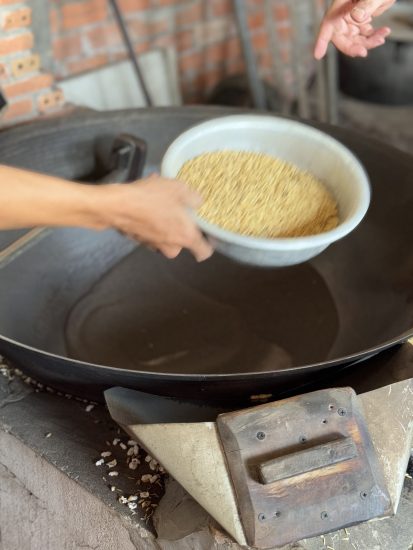
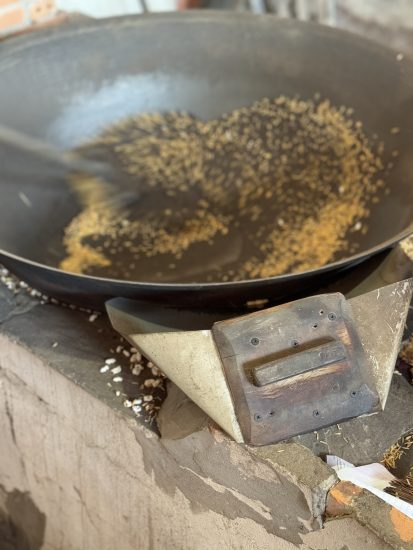
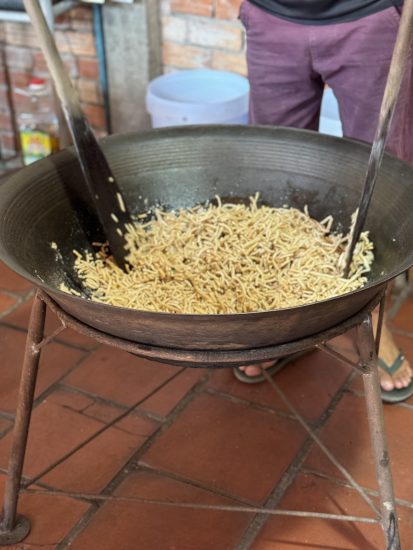
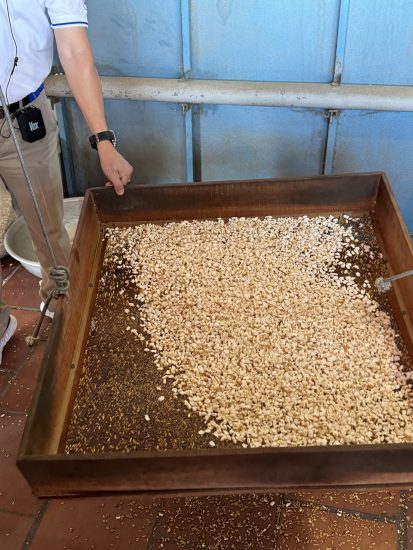
My favorite was a crispy puffed rice that came in a vaariety of flavors. Whole grains of rice are added to a large wok, black sand is places over it, and then the entire wok is placed over fire. The rice pops, it’s filtered through mesh screens to separate out the sand, and then the rice is combined with syrups or other liqud to create a sweeet confection. Think of it as a local version of Rice Krispy treats. Yummmmm!
DAY 8: My Tho & Ho Chi Minh City
The ship docks at the port in My Tho, for disembarkation and the ride to Ho Chi Minh City. The trip is about an hour and a half, with one comfort stop along the way.
Three night post cruise excursions are offered in Ho Chi Minh City. We caught a flight home that evening, so we only had a few hours to walk around the city. I wish we had stayed on for a few days.
The Price
Cruise pricing is full of special offers. You’ll find lots of bundling, two-for-ones, included air, and special discounts.
You’ll need to do your own personal research to evaluate what’s important to you on any cruise, and the price point that is comfortable for your budget. Armed with that information and knowledge, you can book directly with a cruise line or use travel agents with good cruise knowledge. If you’re looking for a good cruise agent, get in touch, we’ll be happy to help.
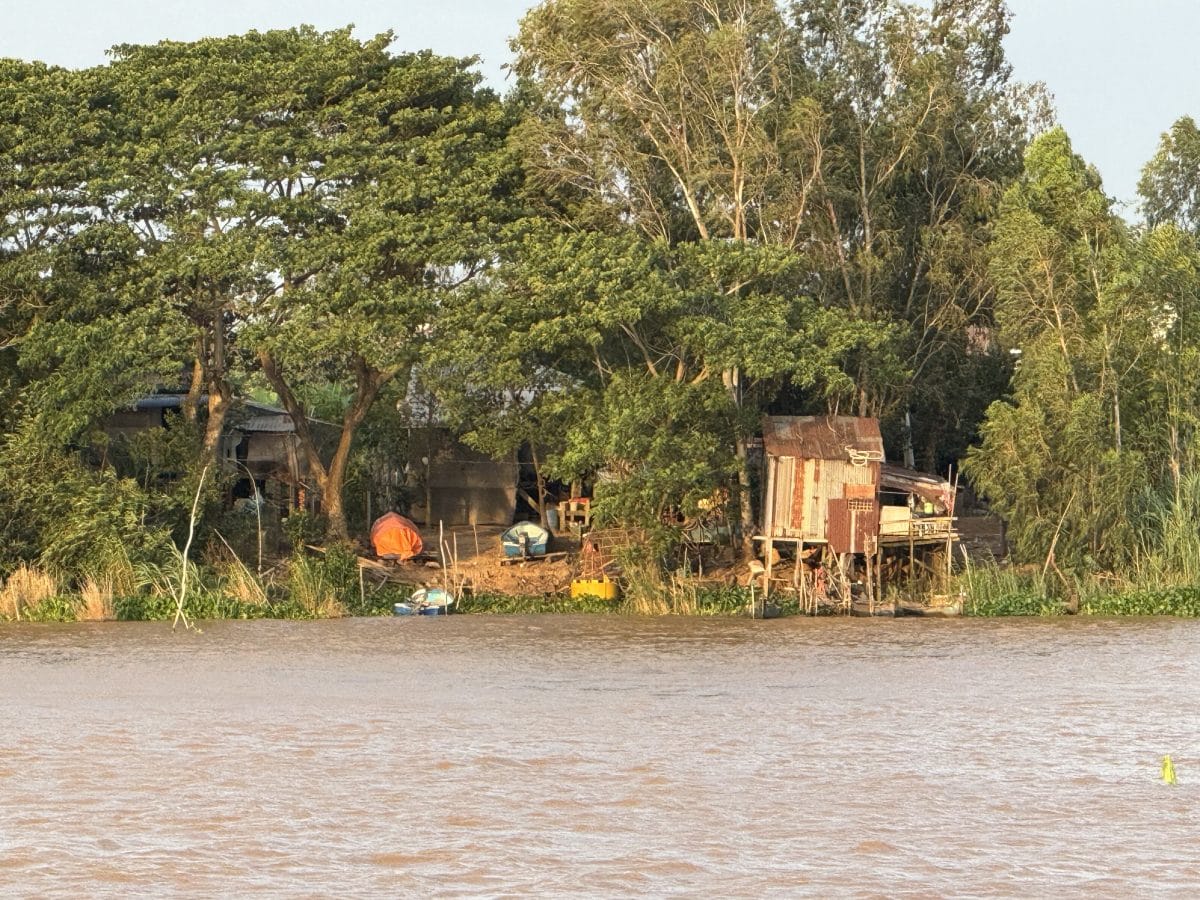
A quick look at 2025 Riches of the Mekong sailings, offered in both directions (Siem Reap to Ho Chi Minh City and the reverse), show fares in the range of $2320-3539 per person. Rates vary based on sail date and type of cabin. You can see 2025 dates and pricing here.
Prices include all meals, most beverages, wine with lunch and dinner, shore excursions, grautities for tour guides and drivers, port charges, and wifi. Not included are airfare and visas, crew gratuities, premium alcohol, and pre- and post-cruise tours.
Gratuities
Mention tipping in a group of people and it’s sure to elicit a lively discussion. I wish all service staff were paid a living wage, with consumer prices adjusted accordingly, and that tipping would cease to exist. I know that won’t happen any time soon. Until then, I have accepted that it is an additional expense to factor into a vacation budget.
Please do the same.
This is not the time to make a political statement about the unfairness of tipping. Your cruise staff work hard for you every single day. You’ve enjoyed a stateroom that was freshened twice daily, and any request was graciously handled. The waitstaff is not only busy filling water and wine glasses, but bus boys are clearing and cleaning, and servers running out meals as quickly as possible, all while accommodating special requests and helping you have a great time.
They deserve as generous of a tip as you can manage.
Ama recommends $80 per week, per guest, as a gratuity. The entire amount is equally divide among all crew members. The cruise manager, however, is not a part of the ship’s crew. S/he is the person who escorts the pre- and post-cruise tours, and helps with other arrangements while you are on the ship. The recommended gratuity is $30 per week, per guest for the cruise, and an additional $4 per person per day for pre- and post-excursions. Gratuities can be charged to your shipboard account in U.S. dollars.
Is This Ama Waterways Riches of the Mekong Itinerary Right for You?
Cambodia and Vietnam aren’t compelling destinations for everyone. The larger cities are crowded and gritty, the smaller ones are slower paced without many amenities. And most of the stops on the itinerary are places you likely haven’t heard of.
There’s also no getting around the brutal legacy of the Khmer Rouge, and the devastation caused by the genocide. The emotional scars from the Vietnam War may also make this an uncomfortable itinerary, especially for veterans of the war and their families. I know just as many veterans who feel compelled to return to Vietnam as there are those who refuse to set foot in the country. They’re both right.
That challenging dichotomy is part of the reason we found the cruise itinerary compelling, but it is not an itinerary I’d recommend to everyone. For a first river cruise, I’d recommend one of the other Ama itineraries on the Danube, the Rhine, or the Rhone.
This Asia itinerary is special, though, and if you want a cruise that immerses you in parts of the world that you might not otherwise visit, we both recommend this Mekong itinerary. While Tony was uncertain when we booked, once in Cambodia his mind changed, and he wished we had added on days. He found the destinations fascinating, full of history and culture, and appreciated the safety net that Ama provides. I would never have gotten him to visit these countries were it not on the cruise. You may find a cruise to be the safety net you need to visit these destinations.
The time and expense of air fare to Siem Reap or Ho Chi Minh City is substantial. It was a 30+ hour travel day, with two connections heading east, one connection on the return. That can be a tough one on your body and spirit, even flying in business class. With the favorable dollar valuation in both countries, it’s an affordable choice to add on a few days to add a little more relaxation into your vacation.
Worth Reading
I love reading books about the places I visit, especially when they are new countries for me. There are lots of books set in the destinations we visited. Here are a few of my suggestions.
Books set in Cambodia
- The Rent Collector – Set in Stung Meanchey, the largest municipal waste dump in all of Cambodia, this is a story of how residents make their living scavenging recyclables from the trash. It demonstrates that even in a dump in Cambodia–perhaps especially in a dump in Cambodia–everyone deserves a second chance.
- In the Shadow of the Banyon – A young girl comes of age amid the Cambodian killing fields. Her family’s world of carefully guarded royal privilege is swept up in the chaos of revolution and forced exodus.
- A Daughter of Cambodia (3-book series) – One of seven children of a high-ranking government official, Loung Ung lived a privileged life in the Cambodian capital of Phnom Penh until the age of five. Then, in April 1975, Pol Pot’s Khmer Rouge army stormed into the city, forcing Ung’s family to flee and, eventually, to disperse. This is her memoir. The next books in the series are First They Killed my Father and Lucky Child.
- When Broken Glass Floats: Growing Up Under the Khmer Rouge – Chanrithy Him vividly recounts her trek through the hell of the “killing fields,” giving us a child’s-eye view of a Cambodia where rudimentary labor camps for both adults and children are the norm. Non fiction.
- And a movie! The Killing Fields.
Books Set in Vietnam
- The Women – A story of one woman enlisting in the Vietnam war, that shines a light on all women who put themselves in harm’s way and whose sacrifice and commitment to their country has too often been forgotten.
- If I Had Two Lives – A young woman journeys from Vietnam to New York and back, searching for a sense of stability.
- The Mountain Sings – An enveloping, multigenerational tale of the Tran family, set against the backdrop of the Vietnam War.
- Water Buffalo Days: Growing up in Vietnam – As a young boy growing up in the hills of central Vietnam, Nhuong’s companion was Tank, the family water buffalo. Nhuong gives readers a glimpse of himself when he was their age, and tells a thrilling story of how he and Tank together faced the dangers of life in the Vietnamese jungle which was their home. This childrens book is a great story for adults as well.
For Pinterest
Save to your favorite cruise boards and to plan your next cruise vacation.

Disclosure
We received a complimentary cruise for the purpose of reviewing the AmaDara and the Riches of the Mekong itinerary. Ama Waterways respects the integrity of independent storytelling and reporting and has not exerted influence on coverage. The content of this post reflect our personal experiences and opinions.


